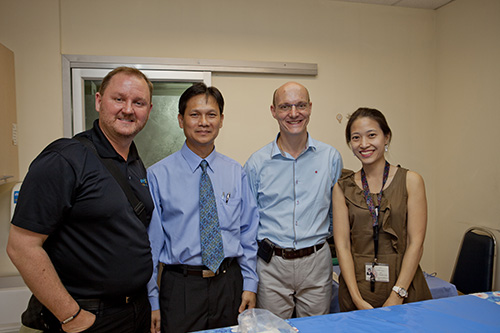A Driving Force in HIV Research
TREAT Asia Interview: Dr. Nittaya Phanuphak

Dr. Nittaya Phanuphak is chief of the Prevention Department and chief of SEARCH (South East Asia Research Collaboration on HIV) at the Thai Red Cross AIDS Research Centre in Bangkok. She started the country’s first test and treat study among Thai men who have sex with men (MSM) and transgender women in 2012. Dr. Phanuphak has collaborated with TREAT Asia on multiple research projects and is the recipient of grants from TREAT Asia and from amfAR’s GMT initiative.
TREAT Asia Report: What led you to develop Thailand’s innovative test and treat program?
Dr. Nittaya Phanuphak: In Thailand, half of the 8,000 new HIV infections that occur each year are in MSM and transgender women, and because of real and perceived stigma, this population is often difficult to reach. They need targeted approaches. We launched the first test and treat program among MSM and transgender women in a few provinces in Thailand in 2012 as a conventional facility-based program, where you hope that people would come to see you at the hospitals. We offered HIV testing and started treatment on those who tested positive in the hospitals.
In 2015, we extended the program to community settings, where our colleagues who are members of MSM and TG communities were already providing education, condoms, and lubricants to their friends though their drop-in centers. We worked with them to strengthen their capacities to provide HIV testing and linkage to care, and even pre-exposure prophylaxis (PrEP) for those who test HIV negative. Some of these centers are also working in MSM and transgender hotspots, including saunas and spas.

TREAT Asia Report: You’re the recipient of amfAR grant funding for a study involving the recruitment of MSM in Thailand for testing and treatment through an online program. Can you tell us about the study?
Dr. Phanuphak: We gradually learned that many people are not comfortable coming even to the drop-in centers for testing. We also learned that over the past half-decade, MSM and transgender women tend to meet online for both social and sexual networking. So we thought that could be a channel for us to reach the higher risk and harder to reach populations.
The Thai Red Cross Research Center already has a website for MSM, Adam’s Love, which launched four years ago and has had more than 3.0 million visitors. Over the past four years Adam’s Love has referred more than 20,000 people to offline testing and treatment.
Our amfAR grant is allowing us to enhance this platform to provide supervised self-testing and counseling online, and even to do online registration at a treatment site for those who test positive but don’t want to go through an in-person registration process.
Once people are interested in having HIV testing, we schedule pre-test counseling through video chatting to help assess their risk. If they have been at risk, we encourage them to be tested and arrange to deliver an HIV test kit to their preferred address. Once they receive that, we schedule a time to do the test together with them and to discuss the results.
For people who test negative, we provide post-test risk reduction counseling, and then make another appointment for six months later for another online self-testing. For people who test positive, we then immediately refer them for HIV confirmation and urge them to begin ART at one of the hospitals affiliated with this study.
TREAT Asia Report: What have you learned since implementing the program?
Dr. Phanuphak: We have tested some people who knew they were at risk for HIV for many years, but didn’t have the courage to come out for testing. Our online model allowed them to think that now is the time to get HIV testing. This shows that no matter how intense your mass media campaign is and how comfortable and friendly you make the clinic, some people will just not come out for testing.
But we have also learned that it’s not easy to link people to care, because we cannot provide treatment online. We may need additional steps to support these people, to empower them to come, at least for confirmation and for linkage to care. So I think we have much more to learn from this study.
TREAT Asia Report: How does the PrEP component of the project fit in with your other efforts to prevent and treat HIV among MSM and transgender individuals?
Dr. Phanuphak: We have integrated PrEP into all of our test and treat models, including in the clinics, hospitals, and drop-in centers. And now we are trying to integrate this into the online platform as well. This does not mean that we can provide PrEP completely in an online model, but we are offering PrEP to anyone who tests negative as part of the post-test and risk reduction counseling. We are looking into increasing adherence to PrEP by setting up an electronic health record (EHR) system, which can send reminders to participants to take their medicine, and we can even do electronic directly observed therapy (DOT) through a video chatting system.

TREAT Asia Report: What still needs to be done in Thailand and the Asia Pacific to address gaps in preventing, testing for, and treating HIV, especially in key affected populations?
Dr. Phanuphak: In Thailand we are following the UNAIDS 90-90-90 targets. The first 90 is to get 90 percent of people with HIV to know their HIV-positive status. I think the country is doing quite well on the other two 90s—to get positive people to be treated, and for those who are treated to have suppressed viral load. But the first 90 is really the challenge. Currently only 30 percent of MSM in our country have ever been tested. So we need to find innovative ways to try to reach the rest of the population. Otherwise that will be the pocket of high-risk people who do not know their status and will be the group with new infections.
TREAT Asia Report: How did your research collaboration with TREAT Asia develop and evolve?
Dr. Phanuphak: We started working with TREAT Asia in 2008 with a small grant to establish our MSM sexual health clinic at the Thai Red Cross Research Centre. In order to draw MSM to our clinic, we began offering anal Pap smears to screen for anal cancer as a main service, and it has been very successful. After that we deepened our study around human papillomavirus (HPV), anal cancer, and HIV among MSM in our clinic. This has generated a lot of information about anal pre-cancerous lesions and HPV infections among Thai MSM, and was among the first studies in this area on Asian MSM. Since then many MSM clients have been coming to our clinics, both for anal Pap smears and HIV testing. We currently [HIV] test about 7,000-8,000 MSM each year, compared to only 1,000 MSM in 2008.
We also received amfAR support to develop the Adam’s Love website, which supplements our service component by bringing MSM to our clinics. This year we received additional funding from amfAR’s NIH IeDEA grant to study amphetamine drug use among HIV-positive and HIV-negative MSM in Bangkok. Amphetamine use is common among the MSM population and can affect sexual risk behavior, as well as adherence to PrEP and HIV treatments.
TREAT Asia Report: Why have you made HPV a focus of your research portfolio, and what have you learned?
Dr. Phanuphak: We found that more than half of the MSM who were tested at our clinic, especially those who were HIV-positive, had the HPV types that can cause lesions that can lead to anal cancer.
We therefore set up services to treat pre-cancerous lesions to prevent them from progressing into anal cancer. Since we identified this problem in Thailand, we figured it must be a problem in neighboring countries as well. So we invited our TREAT Asia network colleagues from Indonesia and Malaysia to join us in forming the ANSAP Network, the anal neoplasia study in Asia and the Pacific. Our colleagues have identified a similar burden of HPV infection and anal pre-cancerous lesions in their countries.
At the same time, data from [TREAT Asia Director] Dr. Annette Sohn’s NIH-funded study of perinatally infected adolescents in Thailand and Vietnam also show that once you have HIV, you are at increased risk of having HPV and developing pre-cancerous lesions of the anus or the cervix.
So for countries such as Thailand, Indonesia, and Vietnam, where the HPV vaccine is still not included in the National Vaccination Program, this is important data that we want to use to drive policy towards providing HPV vaccinations, especially for high-risk populations.
TREAT Asia Report: You are conducting a continuing clinical trial (SEARCH 010), now in its seventh year, to study acute HIV infection in Thai high-risk populations, including MSM, TGW, and sex workers. This is one of the most exciting and scientifically productive “cure” cohort studies being implemented today. Can you describe this study and what you are hoping to accomplish?
Dr. Phanuphak: The SEARCH 010 study has enabled us to add nucleic acid testing to our HIV testing algorithm. That means that people who come for HIV testing at our clinic can be diagnosed just 7 to 10 days after exposure. That’s one to two weeks earlier than with conventional HIV testing.
It’s a test for the virus itself. It lets us identify people whom we call acute HIV cases, which means they contracted HIV within the past four weeks. The hypothesis is that if you can diagnose and begin treating HIV within the first month of infection, the virus can be prevented from settling into the organ systems, and that can increase the chance that the patient can be cured of HIV in the future.
We have been able to diagnose and begin treating almost 400 people with acute HIV infections. These participants will be the candidates for the four to five HIV cure studies waiting to be tested at SEARCH. These studies may include the use of an HIV vaccine, or the use of immunoglobulins or antibodies to boost the body’s immune system to control HIV. We are excited about the potential these studies offer for a future cure.
Share This:
